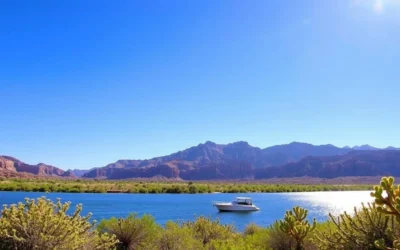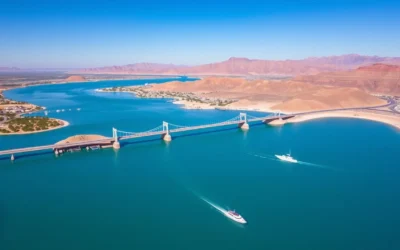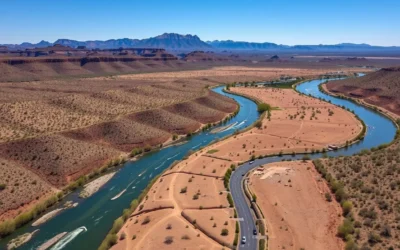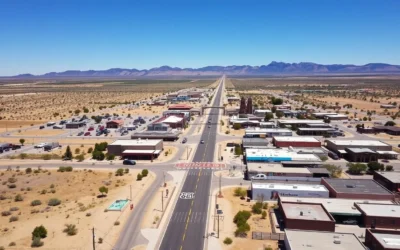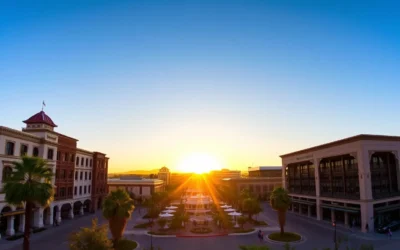With an impressive 330+ days of sunshine annually, Mesa, Arizona outshines nearly every other U.S. city as a premier destination for weather-conscious travelers. This desert gem in the Valley of the Sun offers a unique climate that allows for year-round outdoor adventures, though knowing exactly when to visit can transform a good vacation into an unforgettable experience.
Whether you’re seeking to escape harsh winter conditions, explore desert trails without melting in summer heat, or catch the perfect spring bloom, Mesa’s diverse weather patterns create distinct travel seasons, each with its own appeal. Let’s explore when to plan your Mesa adventure for the perfect weather-savvy trip.
Getting to Mesa: Transportation Options
Phoenix-Mesa Gateway Airport serves as a convenient entry point for visitors
Mesa is easily accessible through two major airports. Phoenix Sky Harbor International Airport, located about 20 minutes west of Mesa, serves as the primary gateway with numerous daily flights from major cities. The closer Phoenix-Mesa Gateway Airport offers a convenient alternative with service from select destinations.
When planning your weather-savvy trip to Mesa, consider that flight prices often fluctuate seasonally. Winter months (November through March) typically see higher airfares due to the influx of “snowbirds” escaping colder climates. For budget-conscious travelers, booking flights during shoulder seasons (April-May or September-October) often yields better deals while still offering pleasant weather conditions.
Ready to Book Your Flight to Mesa?
Find the best flight deals from your city with our trusted travel partners.
Understanding Mesa’s Desert Climate

Mesa’s location in the Sonoran Desert creates a climate characterized by hot, dry summers and mild, pleasant winters. With less than 10 inches of annual rainfall, Mesa experiences an arid climate that contributes to its reputation as a sunshine paradise.
Temperature Patterns Throughout the Year
Mesa’s temperatures follow a predictable pattern that makes weather-savvy trip planning straightforward. Summer months (June-August) regularly see daytime highs exceeding 100°F, while winter months (December-February) offer comfortable daytime temperatures in the 65-75°F range. Spring and fall serve as transitional seasons with gradually changing temperatures.
| Season | Months | Average High (°F) | Average Low (°F) | Rainfall (inches) |
| Winter | December-February | 65-75°F | 40-45°F | 0.7-0.9 |
| Spring | March-May | 75-95°F | 45-65°F | 0.2-0.6 |
| Summer | June-August | 100-106°F | 75-85°F | 0.1-1.1 |
| Fall | September-November | 75-100°F | 50-75°F | 0.5-0.8 |
Monsoon Season Considerations
Mesa’s monsoon season, typically running from mid-June through September, brings occasional dramatic thunderstorms, dust storms (haboobs), and flash flooding. While these events are relatively brief, they can impact outdoor activities and travel plans. The monsoon season coincides with the hottest months, making this period less ideal for weather-sensitive travelers.
Best Months for a Weather-Savvy Trip to Mesa
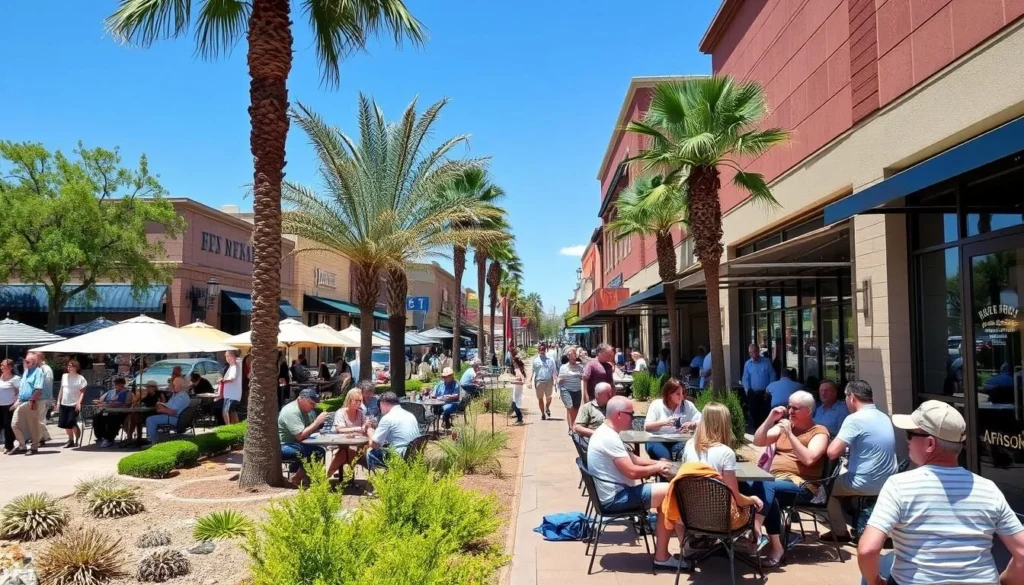
Winter Wonderland: December Through February
Winter stands as Mesa’s peak tourist season, and for good reason. With daytime temperatures hovering between 65-75°F and clear, sunny skies, these months offer perfect conditions for exploring outdoor attractions. Nighttime temperatures can dip into the 40s, so packing layers is advisable.
This season attracts “snowbirds” from colder regions, resulting in higher accommodation prices and larger crowds at popular attractions. However, the perfect weather for hiking, golfing, and outdoor dining makes this premium worth considering for your Mesa weather-savvy trip.
Find Your Perfect Winter Accommodation in Mesa
Book early to secure the best winter rates and availability.
Spring Bloom: March Through May
Spring offers an excellent balance of comfortable temperatures and fewer crowds as the snowbird population begins to depart. March and April provide ideal conditions with daytime highs ranging from 75-85°F, perfect for exploring Mesa’s outdoor attractions and witnessing the desert bloom.
By May, temperatures begin climbing into the 90s, but mornings and evenings remain pleasant. This transitional month offers excellent value as accommodation prices drop while conditions remain favorable for most activities.
“Spring in Mesa transforms the desert into a canvas of wildflowers and blooming cacti. The comfortable temperatures and reduced crowds make it my favorite time to recommend for visitors seeking the perfect weather-savvy trip.”
Summer Strategies: June Through August
Summer in Mesa brings intense heat, with daytime temperatures consistently exceeding 100°F. While this deters many visitors, creating the lowest accommodation rates of the year, a weather-savvy traveler can still enjoy Mesa with proper planning.
The key to a successful summer visit is timing your activities strategically. Early mornings (before 10 AM) offer comfortable conditions for brief outdoor explorations. Afternoons are best spent enjoying Mesa’s excellent indoor attractions or cooling off at water parks and resort pools.
Fall Perfection: September Through November
As temperatures gradually moderate from summer highs, fall emerges as perhaps the most underrated season for a Mesa weather-savvy trip. October and November offer particularly pleasant conditions, with daytime temperatures ranging from 75-85°F and cooler evenings perfect for outdoor dining.
September still retains some summer heat and monsoon activity, but by mid-October, Mesa enters a sweet spot of excellent weather and value. Tourist crowds remain thin until the holiday season, creating an ideal environment for exploring attractions without the winter premium prices.

Navigating Monsoon Season: June to September
The Arizona monsoon season, running approximately from mid-June through September, brings a dramatic shift to Mesa’s typically dry climate. While the season accounts for about one-third of Mesa’s annual rainfall, precipitation occurs in brief, intense bursts rather than extended periods.
What to Expect During Monsoon Season
Monsoon storms typically follow a pattern: intense heat builds during the day, thunderstorms develop in the afternoon or evening, followed by rapid clearing. These storms can produce spectacular lightning displays, dust storms (haboobs), and occasional flash flooding in low-lying areas.
For weather-savvy travelers visiting during monsoon season, flexibility is key. Plan important outdoor activities in the morning hours when storms are less likely, and have indoor alternatives ready for afternoons. Most storms pass quickly, often leaving clearer, temporarily cooler conditions in their wake.
Monsoon Safety Tip: Never attempt to drive through flooded roadways. Even shallow-looking water can conceal washouts or have dangerous currents. Remember the safety slogan: “Turn Around, Don’t Drown.”
Photography Opportunities During Monsoon Season
For photography enthusiasts, monsoon season offers unparalleled opportunities to capture dramatic desert landscapes. The combination of towering storm clouds, lightning, and golden light creates stunning conditions for landscape photography, particularly with the Superstition Mountains as a backdrop.
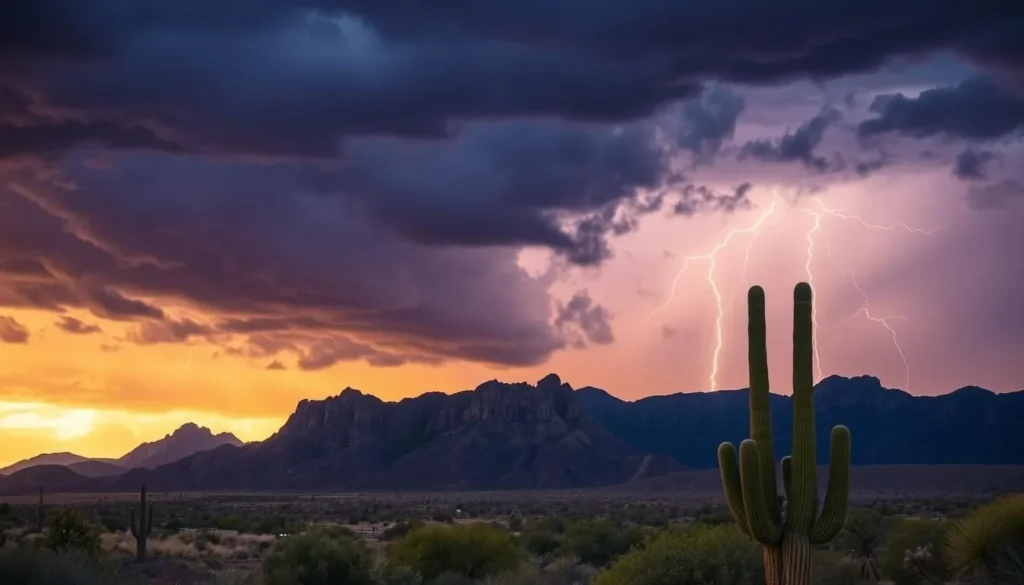
Seasonal Activities for Your Weather-Savvy Mesa Trip
Winter Activities
- Hiking in Usery Mountain Regional Park
- Golfing at one of Mesa’s 40+ courses
- Exploring the Desert Botanical Garden
- Attending MLB Spring Training (February-March)
- Day trips to the Apache Trail scenic drive
Spring Activities
- Wildflower viewing at Lost Dutchman State Park
- Kayaking on the Salt River
- Visiting the Mesa Fresh Foodie Trail
- Attending the Mesa Arts Festival
- Exploring the Superstition Mountain Museum
Fall Activities
- Mountain biking on desert trails
- Exploring downtown Mesa’s arts district
- Attending the Mesa Food Truck Festival
- Sunset photography at Saguaro Lake
- Visiting the Arizona Museum of Natural History
Summer Indoor Escapes
When summer temperatures soar, Mesa offers excellent indoor attractions to escape the heat while still enjoying your trip:
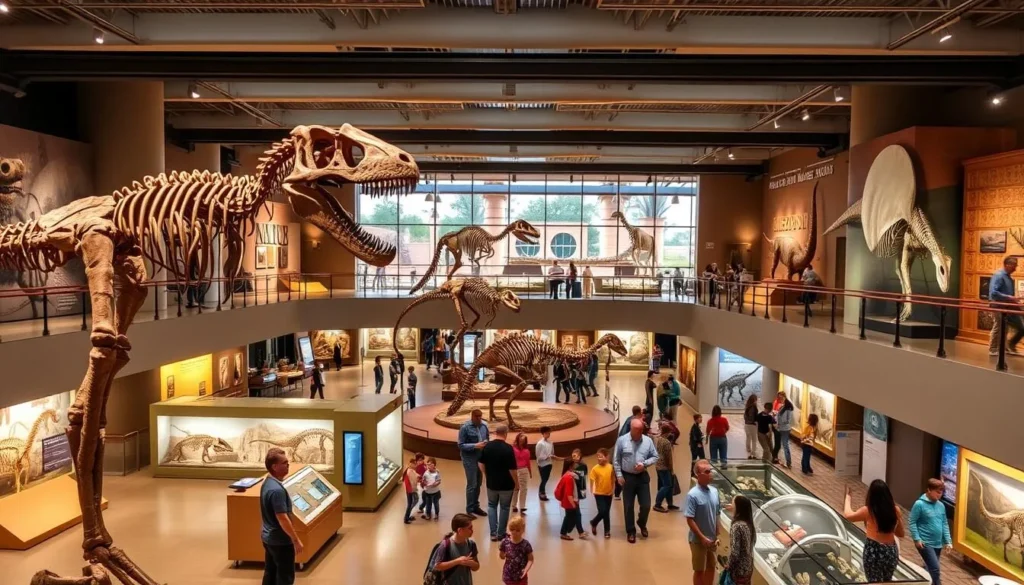
- Arizona Museum of Natural History – Explore dinosaur exhibits and Arizona’s natural wonders in air-conditioned comfort
- Mesa Arts Center – Enjoy rotating art exhibitions and performances in this modern cultural complex
- Superstition Springs Center – Shop and dine in this climate-controlled mall during peak afternoon heat
- i.d.e.a. Museum – Perfect for families with children, offering interactive exhibits in a cool environment
- Mesa Historical Museum – Learn about local history while escaping the summer heat
Explore Mesa’s Top Attractions
Book guided tours and activities to make the most of your weather-savvy trip.
Where to Stay: Accommodation Planning by Season

Mesa’s accommodation options range from luxury resorts to budget-friendly hotels, with availability and pricing fluctuating significantly by season. Understanding these patterns is essential for a weather-savvy trip that maximizes value.
Winter Accommodation Strategy (December-February)
As Mesa’s peak season, winter requires advance booking, ideally 3-6 months ahead for the best selection and rates. Resort properties often charge premium prices, especially during holiday periods and Spring Training. For better value, consider:
- Booking mid-week stays when rates are typically lower
- Exploring vacation rentals for longer stays
- Looking at properties in East Mesa for better rates
- Considering package deals that include golf or other activities
Shoulder Season Value (March-May, October-November)
These transitional months offer an excellent balance of pleasant weather and value. As winter visitors depart, many properties offer incentives to maintain occupancy. Look for:
- Resort packages with spa or dining credits
- Reduced golf fees included with accommodation
- Special rates on premium properties
- Last-minute deals, especially in May and October
Summer Bargains (June-September)
Summer presents the absolute best value for accommodations in Mesa, with rates often 50-70% lower than winter prices. Many luxury resorts offer their lowest rates of the year, often including extras to entice heat-tolerant travelers:
- Resort credits for dining and activities
- Complimentary spa treatments or golf rounds
- Free upgrades to premium rooms
- Special pool access and amenities
Find Your Perfect Mesa Accommodation
Compare hotels, resorts, and vacation rentals to match your seasonal preferences.
Getting Around Mesa: Transportation Tips
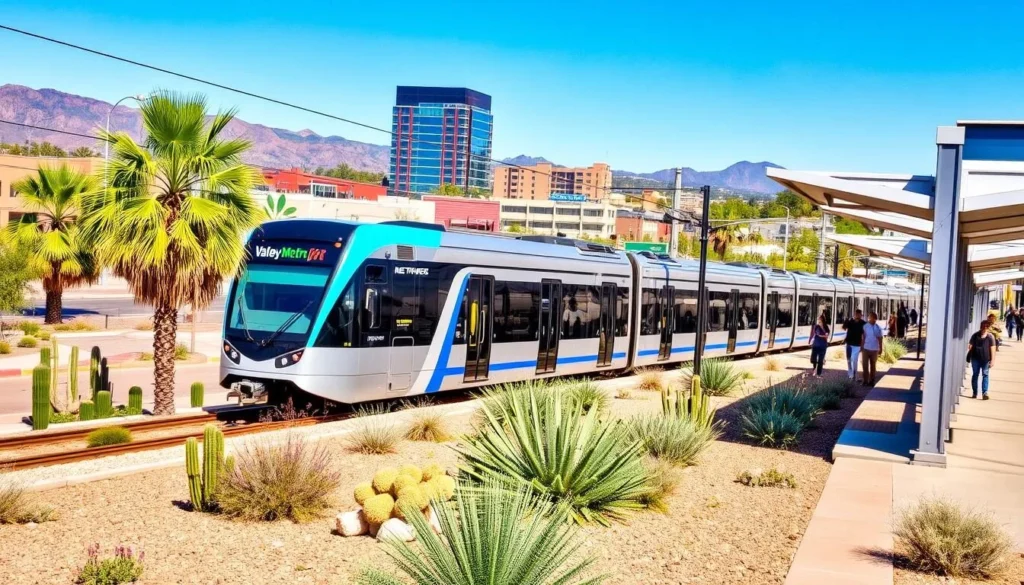
Navigating Mesa efficiently requires understanding both the layout of the city and how weather conditions might affect your transportation choices throughout the year.
Rental Car Considerations
For most visitors, renting a car provides the most flexibility for exploring Mesa and the surrounding attractions. When planning your weather-savvy trip, consider these seasonal factors:
- Summer: Choose a vehicle with reliable air conditioning and consider upgrading to a model with tinted windows and light-colored exterior
- Monsoon Season: Opt for an SUV with higher clearance if you plan to explore desert areas or during the monsoon season
- Winter/Spring: Standard vehicles are suitable for Mesa’s mild winter and spring conditions
Reserve Your Mesa Rental Car
Secure the perfect vehicle for your weather-savvy Mesa adventure.
Public Transportation Options
Mesa offers several public transportation options that can be particularly useful during extreme weather conditions:
- Valley Metro Light Rail: Connects Mesa to Tempe and Phoenix with air-conditioned cars – ideal during summer heat
- Valley Metro Bus System: Provides service throughout Mesa with climate-controlled vehicles
- Rideshare Services: Uber and Lyft operate throughout Mesa and can be convenient for shorter trips
Weather-Savvy Transportation Planning
Adjust your transportation strategy based on seasonal conditions:
- Summer: Plan car trips for early morning or evening, use public transportation during peak heat
- Winter/Spring: Take advantage of perfect weather for walking in downtown areas and parks
- Monsoon Season: Check weather forecasts before driving, especially in late afternoons when storms typically develop
Seasonal Packing Tips for Mesa
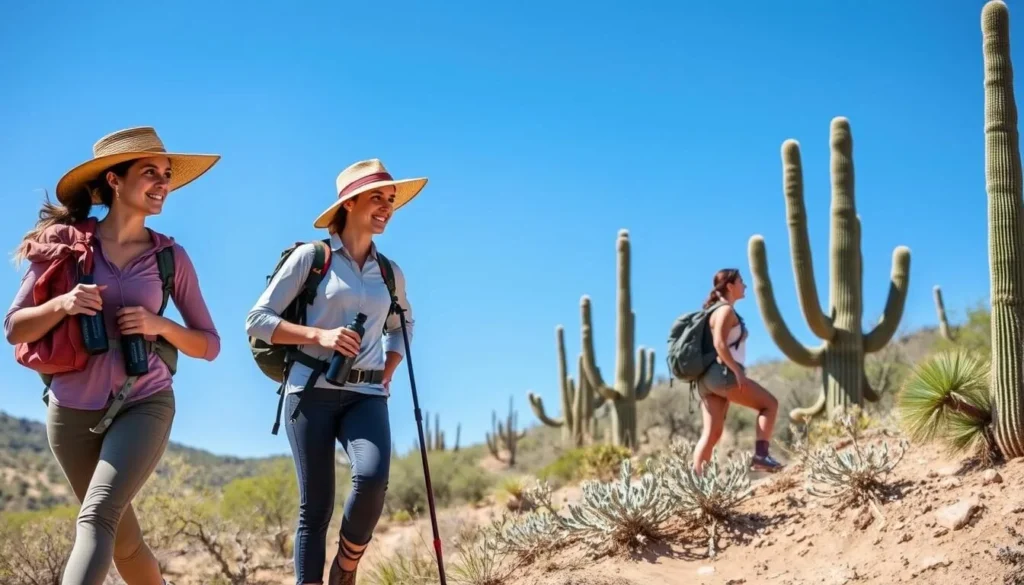
Packing appropriately for Mesa’s climate will significantly enhance your comfort during your weather-savvy trip. The desert environment requires specific considerations regardless of season.
Year-Round Essentials
- Sunscreen (minimum SPF 30)
- Sunglasses with UV protection
- Wide-brimmed hat
- Reusable water bottle
- Lip balm with SPF
- Moisturizer (the desert air is very dry)
Seasonal Packing Lists
| Season | Clothing | Accessories | Special Considerations |
| Winter (Dec-Feb) | Layers, light jacket, long pants, light sweaters | Light scarf, closed-toe shoes | Evenings can be chilly (40s°F) |
| Spring (Mar-May) | Light layers, shorts, t-shirts, light long-sleeve shirts | Hiking shoes, swimming attire | Temperatures vary widely throughout the day |
| Summer (Jun-Aug) | Lightweight, breathable fabrics, shorts, tank tops | Cooling towel, extra water bottles | Avoid dark colors that absorb heat |
| Fall (Sep-Nov) | Light layers, shorts transitioning to long pants | Light jacket for evenings | Early fall resembles summer, late fall more like winter |
Desert Hiking Tip: Even in cooler months, the desert sun is intense. Wear light, long-sleeve shirts and pants when hiking to protect from sun exposure rather than relying solely on sunscreen.
Special Weather Events and Phenomena
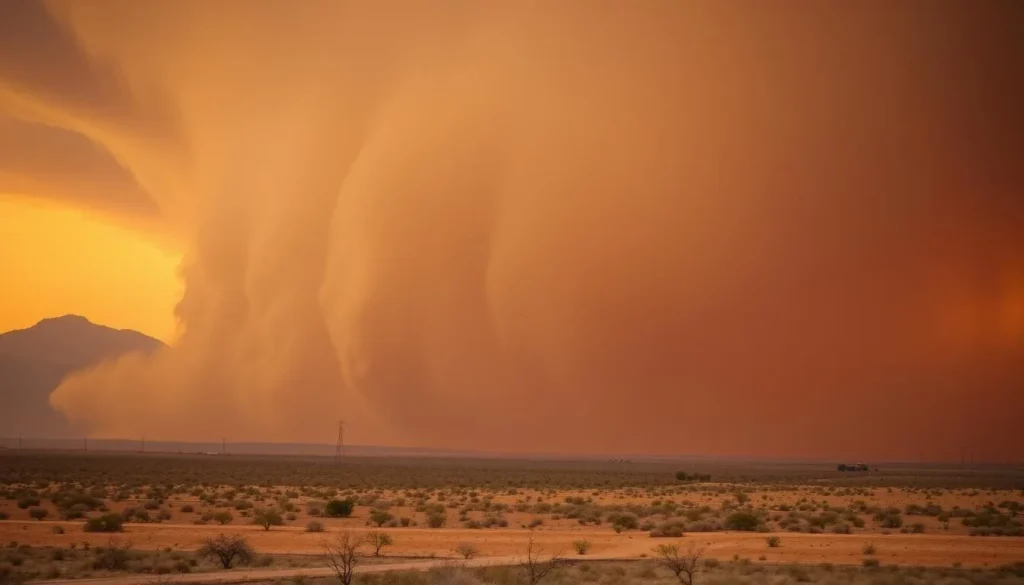
Haboobs: Mesa’s Dramatic Dust Storms
During monsoon season, Mesa occasionally experiences haboobs—massive dust storms that can reduce visibility to near zero in minutes. These impressive weather events typically occur before thunderstorms when powerful downdrafts create walls of dust that can reach heights of several thousand feet.
If you encounter a haboob while driving, pull completely off the roadway, turn off lights, set the emergency brake, and stay in the vehicle with windows closed until the storm passes. These events typically last 15-30 minutes but create hazardous conditions during their peak.
Microbursts and Flash Floods
Monsoon thunderstorms can produce microbursts—intense, localized downdrafts that create straight-line winds exceeding 100 mph. These sudden events can damage structures and create dangerous conditions. Similarly, the desert landscape channels rainwater quickly, creating flash floods in washes and low-lying areas.
Weather-savvy travelers should monitor forecasts during monsoon season and avoid desert washes and trails when thunderstorms are predicted. Most Mesa hotels and visitor centers provide weather alerts during this season.
Desert Blooms: A Weather-Dependent Spectacle
Following winter rains, Mesa’s desert landscape can transform with wildflower blooms, typically peaking in March and April. The timing and intensity of these blooms depend entirely on winter precipitation patterns, making them a special weather-dependent attraction.
For the best chance of witnessing desert blooms, plan a flexible spring visit and check with local visitor centers about current conditions. Lost Dutchman State Park and Usery Mountain Regional Park offer excellent viewing opportunities when blooms occur.
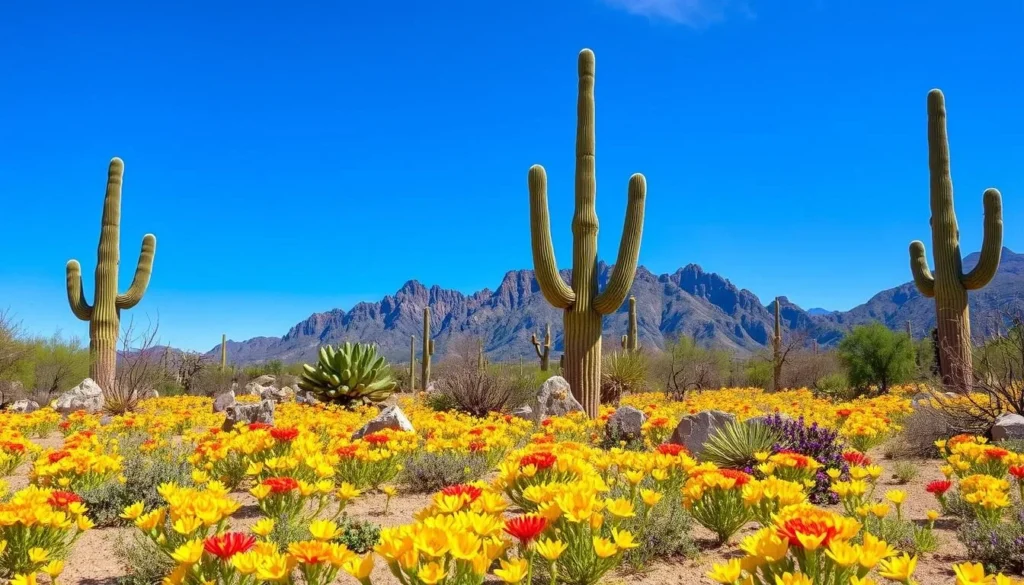
Practical Tips for Weather-Savvy Mesa Visitors
Staying Hydrated in the Desert
Mesa’s dry climate significantly increases water loss through perspiration, often without noticeable sweating. Dehydration can occur rapidly, especially during outdoor activities. Weather-savvy visitors should:
- Drink at least one gallon (4 liters) of water daily during summer visits
- Carry water bottles even for short outings
- Limit alcohol and caffeine consumption, which can increase dehydration
- Watch for signs of dehydration: headache, dizziness, fatigue, and dark urine
Sun Protection Beyond Sunscreen
Mesa’s elevation and clear air intensify UV exposure. While sunscreen is essential, comprehensive sun protection includes:
- Wearing UPF-rated clothing for extended outdoor activities
- Scheduling outdoor activities before 10 AM or after 4 PM during summer
- Seeking shade whenever possible
- Reapplying sunscreen every two hours, more frequently when swimming or sweating
Adjusting to Altitude and Dry Air
Mesa sits at approximately 1,240 feet above sea level. While not high enough to cause altitude sickness, the combination of elevation and extremely dry air can affect visitors, particularly those with respiratory conditions. Consider:
- Using a room humidifier during winter months when indoor heating further reduces humidity
- Applying moisturizer and lip balm regularly
- Using saline nasal spray to prevent nasal dryness
- Allowing a day of adjustment before strenuous activities
Conclusion: Planning Your Perfect Mesa Weather-Savvy Trip
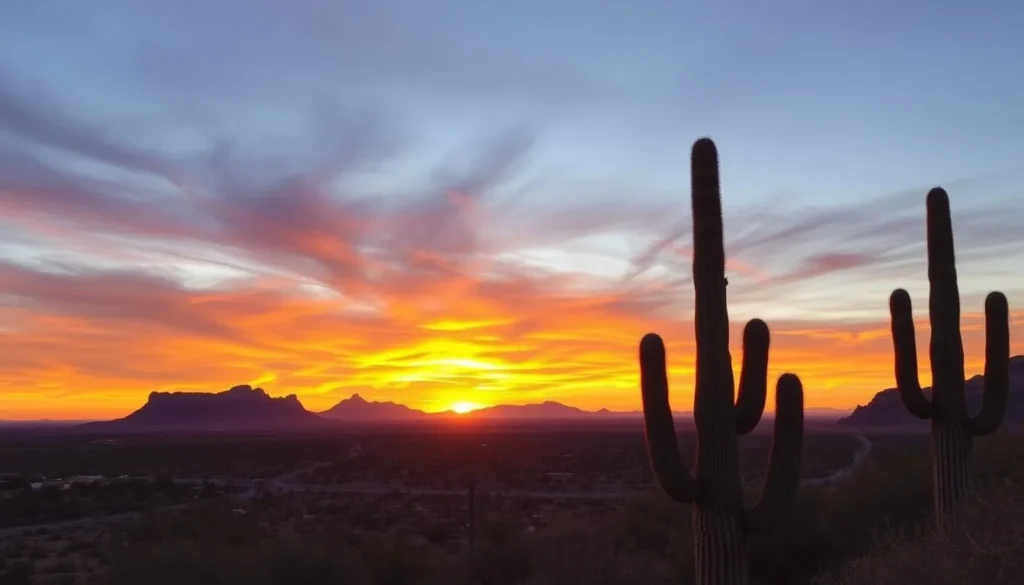
Mesa’s unique desert climate creates distinct travel seasons, each offering its own advantages for the weather-savvy traveler. Winter and spring provide ideal conditions for outdoor exploration with comfortable temperatures and minimal precipitation, though winter brings higher prices and crowds. Summer offers exceptional value for heat-tolerant visitors willing to adapt their schedules, while fall emerges as perhaps the best overall value with pleasant temperatures and thinner crowds.
By aligning your visit with your weather preferences and planning activities accordingly, you can experience the best of Mesa regardless of when you visit. From witnessing spectacular desert blooms in spring to enjoying luxury resort amenities at bargain prices during summer, Mesa rewards travelers who understand its climate patterns.
Pack your sunscreen, bring your sense of adventure, and prepare to experience the magic of the Sonoran Desert in Mesa—where 330+ days of sunshine create endless possibilities for memorable experiences throughout the year.
Ready to Plan Your Mesa Adventure?
Start creating your perfect weather-savvy trip today!
The above is subject to change.
Check back often to TRAVEL.COM for the latest travel tips and deals.

